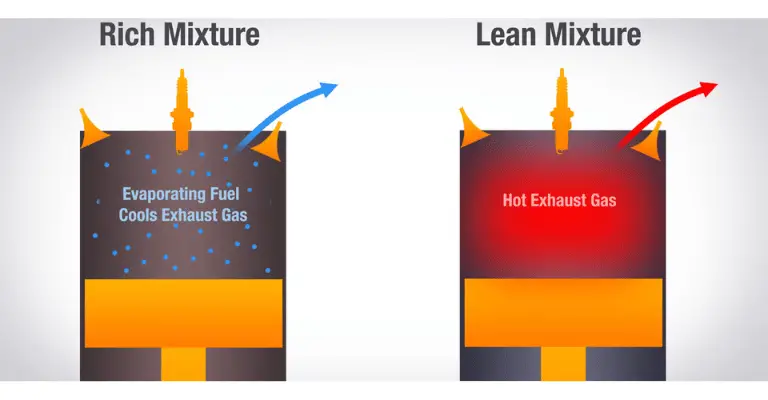In the world of internal combustion engines, maintaining a perfect balance of air and fuel is crucial for optimal performance. This balance, often referred to as the air-fuel ratio, can sometimes go awry, leading to a condition known as a lean mixture. In this comprehensive guide, we delve into the particulars of this phenomenon, its implications, and the signs that indicate you might have an engine running lean. So what’re you waiting for? Let’s get to it!
What You Need To Know About Lean Fuel Mixtures
A lean fuel mixture is a scenario where the air-fuel ratio has too much air or not enough fuel. This condition disrupts the optimal functioning of the engine as it deviates from the ideal stoichiometric ratio, which is the perfect balance of air and fuel required for combustion. In most cases, a lean running engine is a symptom of another underlying issue, such as a faulty oxygen sensor, a damaged Mass Air Flow (MAF) sensor, or clogged fuel injectors.
Is A Lean Mixture Dangerous? (It Can Be)

Contrary to what one might think, an engine running lean isn’t a good thing. While it might seem like less fuel consumption would be beneficial, the opposite is true. A lean running engine can actually lead to engine damage, amongst other problems. The lack of adequate fuel can cause the engine to overheat, leading to a phenomenon known as ‘soft seize,’ where excessive friction between the engine piston and the cylinder wall can cause damage. If the situation escalates, the piston could end up grinding against the cylinder wall, causing serious damage to multiple components.
How To Tell
Identifying an engine running lean is crucial for the health of your motorcycle. A keen awareness of the symptoms can prevent long-term damage and costly repairs. Here are some of the common symptoms that indicate a lean air fuel mixture.
Related: Motorcycle Wont Idle? Know This
Difficulty Starting
A lean running engine may have trouble starting as there isn’t enough fuel for the initial combustion. This situation could lead to the engine not turning over, causing it to get stuck.
Reduced Performance
A lean engine often results in reduced performance. The motorcycle may have sluggish acceleration, operate roughly, or struggle, especially when going uphill. In extreme cases, the motorcycle might even backfire or pop when decelerating.
White Spark Plugs
Your spark plugs can also indicate a lean mixture. Normally, spark plugs are a brown or grey color due to regular ignition. However, in a lean condition, they turn white or are too clean, indicating that there isn’t enough fuel being burnt in the air fuel mixture.
Related: Why Is My Motorcycle Losing Power When Accelerating?
Illuminated Check Engine Light
Modern motorcycles are equipped with numerous sensors, including those that monitor how much fuel is in present in the exhaust gases. If these sensors detect an engine running lean, the check engine light will illuminate on your dashboard.
Complete Engine Stalling
In extreme cases, a lean engine might cause the engine to stall. As you drive, the fuel ratio levels may become so low that the engine is unable to continue operating, leading to a complete stall.
What Causes These Problems?
Several factors could cause a lean fuel mixture. They include:
- Clogged fuel filter: A fuel filter ensures a clean flow of fuel to the engine. If it gets clogged, it could limit the amount of fuel reaching the engine, resulting in a lean condition.
- Faulty oxygen sensor: The oxygen sensor measures the amount of oxygen in the engine and sends this information to the motorcycle’s computer. If the sensor is faulty, it could send incorrect information, causing a lean mixture.
- Low fuel pressure: This could be due to a defective fuel pump or fuel pressure regulator.
- Vacuum leak: Leaks in your engine or exhaust system can disrupt the air-fuel ratio, leading to a lean mixture.
- Clogged fuel injectors: If the fuel injectors become clogged, the flow of fuel to the engine could be limited, causing a lean condition.
How To Resolve A Lean Fuel Mixture
Addressing a lean mixture involves diagnosing the underlying problem and resolving it. Components like the oxygen sensor, MAF sensor, fuel pump, and fuel filter are usually best replaced. However, in the case of dirty fuel injectors, cleaning and reinstalling them might suffice.
Read next: White Smoke From Motorcycle Exhaust? Know This (2023)
Recap of Important Points
A lean fuel mixture is a condition that can lead to significant damage to your motorcycle’s engine if left unchecked. Identifying the symptoms early on and addressing the underlying issues can prevent costly repairs and extend the lifespan of your motorcycle. All-in-all, an engine running lean is a serious issue that requires immediate attention. If you suspect your engine is running lean, it is highly recommended to have it checked by a professional mechanic to prevent further damage.
Read next: Motorcycle Goes Into Gear But Wont Move? Do This